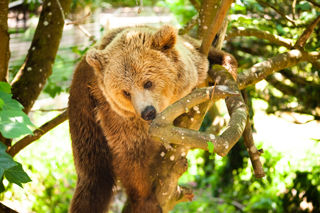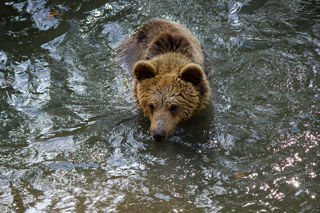
European Brown Bear
Ursus arctos arctos
Brown bears are powerful with short, thick limbs, a big, heavily built body and a distinct shoulder hump, which is due to the large muscles needed for digging up roots and defending territory. Their long claws are specially adapted for digging and can measure up to 10cm.
Behaviour
Undergo a winter torpor, relying on fat reserves that they have built up over the summer period in order to see them through the winter months. Hibernation dens are usually caves.
Mostly solitary, but will gather in large numbers at important food sources, therefore there is a social hierarchy based on age and size (adult male bears being at the top). Females raise cubs on their own, having given birth during the winter hibernation period.
UK Status
Bears have a long history in the UK, however evidence of them in the fossil record stops around the end of the medieval period (1066 onwards). After this, bear remains are only found in London probably due to bear baiting arenas.
Threats
Historically, bears have been used for entertainment purposes (bear baiting and bear dancing) and sadly this still occurs throughout the world. Bears are opportunistic feeders and are attracted to high human density areas to take advantage of our food sources; this leads to direct conflict.
Poaching (for gall bladders and paws) and canned hunting are big problems for most European brown bears. Habitat loss, persecution and accidental mortality are all threats for the European populations of brown bears.

Photograph: Emma Herrod
Distribution
Most widely distributed bear. Historically, they were once native to much of Asia, northern Africa, Europe and North America, however today, numbers have become greatly reduced, even becoming extinct in some areas.
Habitat
They occupy a huge range of habitat types, from temperate rainforests, arctic scrublands, and coastal areas even to dry desert edges. This is thought to enable them to exploit a wide variety of food items seasonally.
Diet
Extremely varied omnivorous diet (meat and vegetation) which changes drastically through the seasons. Up to 75% of diet is made up of plant material (such as fruit, nuts, and acorns). Their daily calorific intake during summer and autumn can reach up to 20,000 calories in order to put enough weight on to safely see them through their winter torpor.
Wildwood inside information
Mish and Lucy's playful behaviour has made them a crowd favourite since their arrival at Wildwood in 2021.
Discovered abandoned on the side of a mountain in Albania, rescuers worked hard to rehabilitate the pair and try to re-establish them in the wild but these attempts failed.
They now live happily in their 1.5 acre enclosure, with plenty of space to roam and exhibit their natural behaviours - which includes climbing trees! Mish is a fantastic older brother to Lucy and is recognisable by his bigger, bulkier build. Lucy, on the other hand, has retained some teddy bear features, with a cub-like face and a smaller stature than Mish.
Family facts
Brown Bears can pack on a massive 180kg of fat during the autumn in order to get them through the winter.
Male Brown bears can be at least 30% larger than females.
-
Wildwood Trust is dedicated to providing a safe and loving home for bears who have faced unimaginable hardship, and giving them a second chance at life. Sadly, not every bear gets to live freely in the wild. Many are imprisoned in private collections, bred for hunting, caged and farmed, or forced to perform in circuses.



